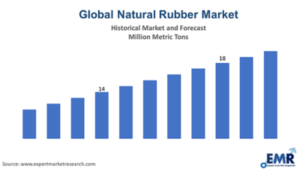Global natural rubber forecast with a CAGR of 4.8 percent through 2028
Sheridan, WY – The global natural rubber market demand reached a volume of 15.2 million metric tons in 2020. The demand is further expected to grow at a CAGR of 4.8% in the forecast period of 2023-2028 according to Expert Market Research.
The Asia Pacific is the largest regional market for natural rubber. Asian countries like Thailand, Indonesia, and Malaysia are the major suppliers in the market. Vietnam is also emerging as a significant sourcing location and holds a potential to be a major producer in the Asia Pacific region in the coming years. The demand in the Asia Pacific is primarily driven by the growing automobile sector and the increasing demand for latex products, like condoms, gloves, and others. Thailand accounts for the largest share of the global supply market, with a 37% market share. The natural rubber market in Thailand is supported by abundant sourcing locations, quality factors, low prices, and a surplus supply. Other countries emerging as major natural rubber producers include Ivory Coast and Cambodia, among others.
China relies on imports to meet the regional natural rubber requirement. It meets 85% of its demand through imports, and that makes it the largest importer of the substance. The United States also imports an enormous volume of natural rubber from countries like the Ivory Coast. Malaysia is also an importer of the product due to the excess domestic demand, along with being the largest exporter of finished rubber goods. In terms of exports, Thailand is the leading exporter, exporting the majority of its output. Other major exporting countries include Vietnam and Myanmar.
The growing demand for tires is supporting the natural rubber market growth, especially in emerging nations like India and China. The growing automobile sector is supporting the demand for natural rubber. The most dominant application sector in the Southeast Asian market is latex goods like gloves and dipped products owing to efficient R&D undertakings and quality.
The natural rubber market is being driven by the increasing demand for tires as well as latex goods like gloves, belts, catheters, condoms, and other industrial durables, among others. The growing market for these products is fueling the demand for natural rubber as well.
The demand for natural rubber is aided by the growing economies like India and China, among others. The tyre manufacturers are planning to shift their production base to low-cost producing nations, like India, China, and others. This will help them garner more demand from the consumers as it would be more cost-effective. This plan would also drive the overall automobile sector further and provide an impetus to natural rubber demand. The demand for natural rubber is being supported by the rising demand from developing nations and their rising GDP.
The growing environmental consciousness is leading to the wide utilization of natural rubber instead of synthetic rubber as it is plant-based, biodegradable, renewable, and has a minimal environmental impact during harvesting and manufacturing as no artificial coloring or chemical softeners are used. The advantages of natural rubber, like cost-effectiveness, flexibility, low odor, water resistance, and high tensile strength, are contributing to the natural rubber market expansion. The antibacterial characteristic of natural rubber is resulting in its increased utilization to produce footwear and gloves that remain in close contact with the skin. Natural rubber is also considered ideal as a flooring material as it is slip-resistant, waterproof, easy to maintain and durable. The government initiatives towards offering financial assistance to motivate the growers to take up rubber cultivation and ensure the sustainability of the raw material are providing impetus to the market development. For instance, the National Rubber Policy 2019, India highlights the government’s efforts to bolster the production of natural rubber in the country. The report also mentions that a study team from Auto Tyres Manufacturing Association (ATMA) visited Tripura, an Indian state, to explore possibilities of augmenting the natural rubber production.

